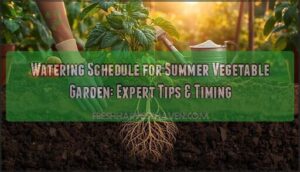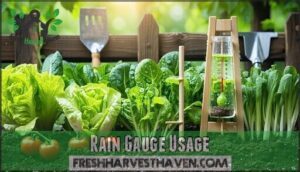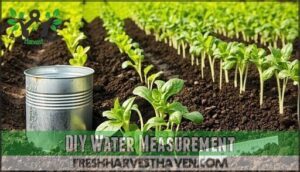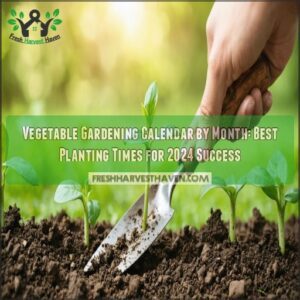This site is supported by our readers. We may earn a commission, at no cost to you, if you purchase through links.

Water 2-3 times weekly, delivering 1-1.5 inches total per week.
Check soil moisture by sticking your finger an inch deep – if it’s dry, it’s time to water.
Sandy soils need more frequent watering, while clay soils hold moisture longer.
Water early morning before temperatures rise to reduce evaporation and disease risk.
Container vegetables may need daily watering during heat waves, but garden beds with good mulch can go longer between sessions.
The secret lies in training roots to grow deep rather than staying shallow near the surface, which is key to a successful summer vegetable garden with good mulch.
Table Of Contents
- Key Takeaways
- Soil Preparation Matters
- Watering Frequency Guide
- Effective Watering Techniques
- Measuring Water Application
- Plant Specific Watering
- Factors Influencing Watering
- Summer Vegetable Care
- Watering Schedule Tips
- Frequently Asked Questions (FAQs)
- When should you water a vegetable garden?
- How often should I water my Garden?
- How do you know if it’s time to water a vegetable garden?
- Should I water my vegetables in the morning?
- Do you need to adjust your vegetable garden watering schedule?
- Do vegetable gardens need to be watered during winter?
- What are the three rules of watering?
- What vegetables need to be watered every day?
- How often should I water my vegetable garden in summer?
- How long should I run my sprinklers on my vegetable garden?
- Conclusion
Key Takeaways
- Water 2-3 times weekly with deep soaking – You’ll get better results by delivering 1-1.5 inches total per week rather than daily sprinkling, which trains roots to grow deep and become drought-resistant.
- Water early morning between 5-9 AM – You’ll reduce evaporation by 50%, prevent fungal diseases, and give plants time to absorb moisture before the heat hits.
- Check soil moisture before watering – You should stick your finger 1-2 inches deep and only water when it feels dry, since different soil types hold water differently.
- Adjust your schedule based on weather and plant needs – You’ll need to increase the frequency during heat waves, reduce it after rainfall, and remember that seedlings need daily water while established plants prefer deeper, less frequent watering.
Soil Preparation Matters
Your soil’s foundation determines how well your vegetables thrive during summer’s heat, making proper preparation essential for water retention and plant health.
Well-amended soil with organic matter creates the perfect environment for deep root growth and efficient water use.
Organic Matter Importance
Adding organic matter to your garden soil creates a foundation that dramatically improves soil health.
Compost benefits include better water retention, enhanced soil structure, and increased nutrient cycling.
When you add just a quarter-inch of compost per season, you’re boosting microbe growth that transforms nutrients into plant-available forms.
This organic matter acts like a sponge, holding moisture longer between waterings.
Organic fertilizers break down slowly, feeding your vegetables consistently throughout summer.
The improved soil moisture levels mean you’ll water less frequently while your plants stay healthier and more resilient during hot weather.
Understanding Soil Types
Before watering your vegetables, you’ll need to identify your soil type since it directly impacts your watering schedule and soil moisture levels.
Each type behaves differently in terms of water retention and soil structure.
- Sandy loam drains quickly but requires more frequent watering
- Clay soil holds moisture longer but can become waterlogged
- Loamy soil provides ideal drainage and nutrient balance
- Silt feels smooth and maintains good soil moisture levels
Test your soil pH and conduct a soil moisture test to optimize soil health.
Improving Water Retention
Once you understand your soil type, you can boost its water-holding power with smart soil amendments.
Think of organic matter as nature’s sponge – it transforms thirsty sand into moisture-retaining gold. Adding 2-3 inches of compost annually creates drought resistance while improving soil structure. Mulching around plants cuts evaporation by half, giving you serious water conservation benefits.
Proper soil preparation techniques are essential for achieving ideal water retention and soil health.
| Amendment Type | Water Retention Benefit |
|---|---|
| Compost | Increases moisture holding 25-50% |
| Organic mulch | Reduces evaporation 50-70% |
| Clay amendments | Improves sandy soil drainage |
| Leaf mold | Boosts soil moisture capacity |
| Well-aged manure | Enhances water and nutrient retention |
This efficient watering foundation helps drought tolerant vegetables thrive even during hot spells.
Watering Frequency Guide
Getting your watering schedule right makes the difference between thriving vegetables and struggling plants during summer’s heat.
You’ll need to balance daily attention with weekly water goals while staying flexible when weather patterns shift, which involves complete concepts and understanding the importance of a watering schedule.
Daily Watering Needs
Since seedlings demand twice-daily watering until their roots establish, your daily watering frequency becomes essential during summer heat.
Check soil moisture by testing water depth 2 inches down – dry soil signals immediate watering needs.
Morning hydration works best, providing adequate water pressure for deep root penetration.
Mature vegetables need daily watering when temperatures soar, but avoid overwatering.
Focus on watering deeply rather than frequent shallow applications to encourage strong root systems and better drought tolerance.
Weekly Watering Requirements
Your summer vegetable garden thrives with consistent weekly watering rather than sporadic daily doses. Most vegetables require 1 to 1.5 inches of water per week, including rainfall. This water depth guarantees proper soil moisture penetration without waterlogging roots.
Garden hydration works best when you water deeply 2-3 times weekly instead of light daily sprinkling. This watering frequency encourages strong root development and drought resilience.
- Vegetable water needs vary by plant type—tomatoes and peppers need deep weekly soaking while leafy greens prefer consistent moisture
- Irrigation timing should focus on early morning applications to maximize water absorption and minimize evaporation
- Sandy soils require more frequent weekly watering than clay soils due to faster drainage rates
- Garden watering schedule adjustments become necessary during heat waves when water frequency may need doubling
Adjusting for Weather
Adapting your watering schedule to weather conditions guarantees your vegetables thrive despite Mother Nature’s curveballs. Monitor the weather forecast weekly to plan ahead effectively.
| Weather Condition | Watering Adjustment | Action Required |
|---|---|---|
| Heat waves | Increase frequency | Water twice daily |
| Rainy periods | Reduce or skip | Check soil moisture |
| High humidity | Decrease frequency | Improve air circulation |
| Strong winds | Add extra water | Protect with windbreaks |
| Drought conditions | Deep, less frequent | Mulch heavily |
During rainfall adjustment, measure precipitation with a rain gauge before calculating water needs. Storm preparation includes checking drainage systems beforehand.
Effective Watering Techniques
You’ll get the best results by watering your vegetables at the soil level rather than spraying from above.
This approach delivers water directly to the roots while keeping leaves dry, which prevents common fungal diseases that thrive in humid summer conditions, particularly those that occur when leaves are consistently humid.
Deep Watering Methods
Deep watering methods transform shallow roots into strong, drought-resistant systems. Water slowly until you achieve complete soil saturation 6-8 inches deep. This approach beats frequent sprinkles every time—your plants develop deeper root hydration patterns that access moisture levels even during dry spells.
Here are five deep watering methods that’ll revolutionize your watering schedule adjustment:
- Soaker hose technique – Place hoses at plant bases for 30-45 minutes
- Basin watering – Create soil wells around plants for targeted water penetration
- Slow-drip bottles – Puncture plastic bottles for gradual soil moistening
- Furrow irrigation – Dig shallow trenches between plant rows
- Hand watering – Use low-pressure settings for controlled application
Using the right soaker hose systems(soaker hose) can substantially improve water efficiency. Effective watering means patience pays off. Proper watering creates resilient plants that’ll thank you during summer’s toughest heat waves.
Drip Irrigation Benefits
Why struggle with wasteful watering when drip irrigation transforms your summer vegetable garden into a water-efficient powerhouse? These systems deliver precise irrigation control directly to plant roots, boosting water efficiency by up to 60% compared to traditional methods.
Your drip systems provide these game-changing benefits:
- Water savings of 40% through reduced evaporation and targeted delivery
- Soil conservation by preventing runoff and maintaining ideal moisture levels
- Disease prevention by keeping foliage dry and reducing fungal issues
- Weed suppression since water reaches only your vegetables, not surrounding weeds
This watering system automates your garden watering tips while you focus on harvesting. Your vegetable garden irrigation becomes hands-off, consistent, and incredibly efficient. By utilizing Drip Irrigation Systems, gardeners can optimize their water usage and promote healthy plant growth.
Avoiding Overhead Sprinklers
Overhead sprinklers create conditions ripe for plant disease by splashing water onto leaves and wasting precious resources through evaporation.
You’re better off targeting the root zone with soaker hose systems or drip irrigation that delivers water exactly where your summer vegetable garden needs it.
This approach maintains proper soil moisture levels while promoting deeper root depth.
Efficient hydration means water conservation and healthier plants.
Garden watering tips like avoiding midday watering further maximize effectiveness.
Measuring Water Application
You’ll need accurate measurements to guarantee your vegetables get the right amount of water without waste.
Think of it like following a recipe – too little water stunts growth, while too much can drown roots and invite disease.
Rain Gauge Usage
A rain gauge acts as your garden’s personal weather station, giving you precise rainfall tracking data.
Smart gauge placement in an open area away from trees helps guarantee accurate water measurement readings.
Here’s how to master rain collection monitoring:
- Position your rain gauge at least 5 feet from buildings or obstacles
- Check readings after each storm for immediate moisture monitoring feedback
- Record weekly totals to track seasonal patterns
- Empty and clean monthly to maintain accuracy
Regular measuring water helps you adjust irrigation schedules perfectly.
When nature provides an inch of rainfall, you can skip watering that week.
This simple tool transforms guesswork into precise garden management, keeping your vegetables happy without waste.
Understanding the importance of summer garden irrigation systems is vital for optimizing water usage and plant growth.
DIY Water Measurement
You don’t need expensive gadgets to measure water accurately in your garden. Simple household items work perfectly for tracking moisture and rainfall amounts.
Start with DIY containers placed around your garden to catch and measure precipitation. Empty tuna cans or straight-sided jars make excellent homemade rain gauges. Check soil moisture by inserting a trowel or your finger two inches deep – if it feels dry, it’s watering time. Accurate rain gauges provide rainfall measurement data to help with this process.
- Use empty containers as makeshift rain gauges for precise measurement
- Test soil with a trowel or finger probe two inches deep
- Create water meters using clear bottles with measurement marks
- Monitor moisture levels with simple soil probes or wooden sticks
- Track rainfall amounts using DIY containers placed strategically around beds
Calculating Water Needs
Once you’ve measured your water application, determining your garden’s water budget becomes straightforward.
Factor in your soil moisture capacity, plant root depth, and evapotranspiration rates.
Most vegetables need 1-2 inches weekly, but adjust for plant specific watering needs.
Sandy soils require frequent applications, while clay holds moisture longer.
Monitor moisture levels regularly and increase watering frequency during peak summer heat.
Plant Specific Watering
Different plants have different thirst levels, and understanding these needs will help you create a watering schedule that keeps each crop happy.
You’ll find that tomatoes need consistent moisture while herbs like rosemary actually prefer drier conditions.
Vegetable Water Requirements
Your summer vegetables demand different amounts of water depending on their type and growth stage.
Leafy greens need consistent soil moisture – about 1 inch daily when temperatures hit 90°F.
Root vegetables like carrots thrive with deep weekly soaks rather than frequent light watering.
Fruit-bearing plants such as tomatoes and cucumbers show ideal crop yield with steady moisture during flowering and fruiting stages.
Monitor for water stress signs like wilting to adjust your watering schedule and boost water conservation.
Succulent Watering Needs
Succulents bring drought tolerance to your summer garden with minimal water conservation demands.
These hardy plants prefer completely dry soil moisture between waterings, making them perfect companions for water-wise gardening.
Succulent watering guidelines:
- Water deeply when soil moisture drops completely dry
- Reduce frequency during dormant winter months substantially
- Check for mushy, translucent leaves indicating overwatering problems
- Watch for wrinkled, shriveled foliage showing underwatering stress
- Verify proper drainage preventing root depth waterlogging issues
This succulent care approach conserves water while maintaining healthy plants throughout your summer garden.
Herb Watering Preferences
Understanding herb watering needs transforms your summer garden success.
Mediterranean herbs like rosemary thrive in dry conditions, reflecting their origins and low water sensitivity. Meanwhile, mint and parsley crave moisture levels that stay consistently damp.
Root depth varies dramatically between herb types – shallow-rooted basil demands frequent drinks, while deep-rooted oregano handles drought like a champ.
Watch for leaf response signals: wilting indicates thirst, while yellowing suggests overwatering.
Plant type trumps everything – match watering frequency to each herb’s nature.
Soil type impact and weather effects require adjustments, but mulching benefits help retain consistent moisture for thirsty herbs while protecting drought-lovers from excess water.
Factors Influencing Watering
You’ll need to take into account several key factors when creating your summer watering schedule since different plants, soil types, and weather conditions all affect how much and how often you should water.
These variables work together to determine whether your vegetables need daily attention or can thrive with less frequent deep watering sessions, considering complete concepts such as the type of plants and soil.
Plant Type Considerations
Each plant type demands different vegetable water requirements based on root depth and growth stages.
Deeprooted vegetables like tomatoes need consistent moisture during fruiting, while shallowrooted vegetables and leafy greens require steady watering for tender growth.
Here’s your plant-specific watering guide:
- Match watering to root crops depth
- Prioritize fruit watering during production
- Keep leafy greens consistently moist
- Adjust for seedling care needs
- Monitor individual vegetable needs
Understanding plant type helps you water smarter, not harder.
Effective summer garden watering techniques can substantially improve plant health and reduce water waste.
Soil Type Impact
Your soil types determine how often you’ll water.
Sandy Loam drains fast, needing frequent watering but excellent soil preparation with compost boosts Water Retention.
Clay Soil holds moisture longer due to high Soil Density, but poor drainage risks waterlogged roots.
Check Moisture Levels regularly – sandy soils need daily attention while clay requires patience.
Soil Moisture testing prevents soil saturation problems.
Smart watering techniques match your soil’s personality.
Weather Condition Effects
Weather throws curveballs at your watering game.
Temperature impact hits hard during heatwaves—you’ll water twice as often when temps soar above 85°F.
Wind damage accelerates moisture loss by 70%, while sun exposure over eight hours doubles water needs.
Humidity levels below 40% spike dehydration, but high humidity risks fungal problems.
Track rainfall effects with a rain gauge—most summer showers don’t penetrate deep enough for vegetables.
Summer Vegetable Care
Summer vegetables face their biggest watering challenges during the hottest months when heat stress can damage your harvest.
You’ll need to adjust your watering schedule and use smart techniques like mulching to keep your plants thriving when temperatures soar.
Mulching Benefits
Mulching transforms your summer garden into a water-saving powerhouse. Organic mulches like straw or shredded leaves create a protective barrier that locks in moisture retention while blocking soil temperature extremes.
You’ll slash your watering needs by up to 50% as mulch prevents evaporation. Weed suppression becomes effortless too – fewer weeds mean less competition for water.
Organic matter gradually breaks down, enriching your soil naturally. Apply 2-3 inches around plants, keeping mulch away from stems to prevent rot.
Water conservation has never been easier, and your vegetables will thank you with stronger growth and better yields.
Watering Schedule Adjustment
During summer’s peak heat, seasonal adjustments become your garden’s lifeline.
Increase watering frequency by 35% when temperatures exceed 85°F to prevent water stress.
Adjusting for rainfall means skipping scheduled irrigation after 0.5+ inches of precipitation.
Drought management requires doubling normal schedules during dry spells.
Irrigation timing shifts are vital—morning watering reduces evaporation by 50% compared to midday sessions.
Monitoring Soil Moisture
Checking your garden’s moisture levels throughout summer keeps your vegetables healthy and productive.
Here’s your monitoring game plan:
- Soil Feel Test – Dig down 2 inches and squeeze the dirt; if it crumbles instead of forming a ball, it’s time to water
- Moisture Meters – These handy gadgets give you precise readings without the guesswork of soil inspection
- Wilting Signs – Look for droopy leaves during morning hours (midday wilting is normal in heat)
- Leaf Discoloration and cracked soil signal your plants need immediate attention for proper vegetable garden care.
You can also evaluate water retention by observing drainage after watering.
Watering Schedule Tips
Creating the right watering schedule can make or break your summer vegetable harvest.
You’ll need to balance timing, frequency, and weather conditions to keep your plants thriving through the hottest months.
Watering in Morning
Morning watering provides ideal timing for your vegetable garden’s success.
Water your vegetables early when the air is cool and your plants can actually use every drop.
Water between 5-9 AM when temperatures stay cool, allowing deep root absorption before heat arrives.
Morning benefits include rapid leaf drying, which supports disease prevention through reduced fungal risks.
This watering methodology maximizes evaporation reduction while promoting root health.
Early morning watering gives plants time to utilize moisture effectively throughout the day.
Avoiding Midday Watering
Skipping midday watering saves your plants from unnecessary stress. Hot afternoon sun causes rapid water evaporation, leaving roots dry despite your efforts. Wet leaves under intense heat can also develop fungal leaf diseases.
Here’s your smart watering approach:
- Choose morning watering between 5-9 AM for best results
- Focus water at soil temperature level, not on foliage
- Save evening hydration as backup, never midday sessions
This schedule prevents water evaporation while protecting your summer garden watering routine from heat damage.
Adjusting for Rainfall
Nature doesn’t follow your watering schedule, but you can work with it instead of against it. Rainfall tracking helps you adjust your garden watering frequency without wasting water or drowning your plants.
Install a rain gauge to measure exactly how much water your garden receives. This simple tool transforms guesswork into precise water conservation. When Mother Nature delivers, your sprinkler system can take a break.
Check soil saturation by digging down two inches. Soggy soil means your water table is happy, but your roots aren’t. Waterlogged vegetables develop root rot faster than you can say "tomato blight."
Smart adjusting for changing conditions means watching weather forecasts and planning ahead. Rainwater harvesting during heavy periods helps with future drought management.
Frequently Asked Questions (FAQs)
When should you water a vegetable garden?
You should water your vegetable garden early morning (5-9 AM) when temperatures are cooler.
This timing reduces evaporation, allows leaves to dry before evening, and gives plants the moisture they need.
How often should I water my Garden?
Surprisingly, you can’t just set it and forget it—your garden needs attention.
Water vegetables deeply 2-3 times weekly, providing 1-5 inches total.
Check soil moisture daily; water when the top inch feels dry.
How do you know if it’s time to water a vegetable garden?
Check your soil by sticking your finger one to two inches deep.
If it feels dry and crumbly, it’s time to water.
Also watch for wilting leaves or dry, cracked soil around plants.
Should I water my vegetables in the morning?
Yes, you should water vegetables in the morning between 5-9 am. This timing lets foliage dry before evening, reducing disease risk while minimizing evaporation from summer heat.
Do you need to adjust your vegetable garden watering schedule?
Your garden’s watering needs shift dramatically as summer progresses. You’ll need to increase frequency during heat waves, adjust for plant growth stages, and monitor soil moisture more closely.
Do vegetable gardens need to be watered during winter?
Winter watering, winter planning, winter care—your vegetable garden’s needs shift dramatically.
You’ll water less frequently since cold weather slows growth and evaporation.
Most vegetables go dormant or die back, requiring minimal moisture until spring planting begins.
What are the three rules of watering?
Water deeply but less often, water early morning to prevent disease, and focus water at soil level rather than leaves.
What vegetables need to be watered every day?
Most vegetables don’t require daily watering, but seedlings need twice-daily water until established. During extreme summer heat, vegetables might need a second daily watering when temperatures soar.
How often should I water my vegetable garden in summer?
During summer’s heat, water your vegetable garden 2-3 times weekly rather than daily sprinkling. Most veggies need 1-5 inches weekly, best applied early morning to encourage deep roots.
How long should I run my sprinklers on my vegetable garden?
Run sprinklers for 30-60 minutes to deliver one inch of water weekly. Check soil moisture two inches deep—it should feel moist, not soggy, for ideal vegetable growth.
Conclusion
Picture your thriving garden in late summer, heavy with tomatoes and peppers that weathered the heat thanks to your smart watering choices.
A successful watering schedule for summer vegetable garden doesn’t require guesswork—it needs consistency and timing.
You’ve learned that deep, infrequent watering builds stronger plants than daily sprinkling.
Morning watering, proper mulching, and understanding your soil type will keep your vegetables productive through August’s scorching days.
Your garden’s success depends on these simple but effective watering practices.
- https://cals.cornell.edu/field-crops/small-grains/diseases-small-grains/foliar-diseases
- https://www.lawnstarter.com/blog/lawn-care-2/soil-types-guide/
- https://nrcca.cals.cornell.edu/soil/CA2/CA0211.1.php
- https://www.uaex.uada.edu/about-extension/united-states-extension-offices.aspx
- https://hort.caes.uga.edu/people/faculty/robert-westerfield.html














